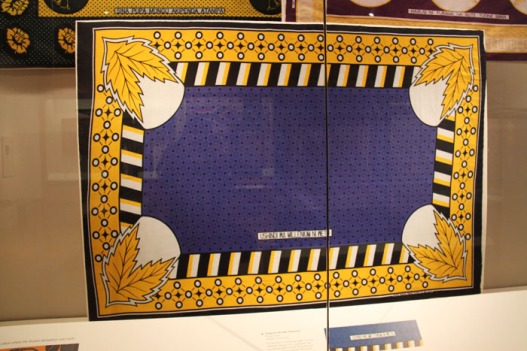When the Kanga first began it was simplicity and plain designs, overtime the development in the designs became more elaborate and vibrant to create a meaning or purpose behind the piece created. Kanga East African textiles are influenced from social and political issues from Tanzania in some of their designs (Ong’oa-Morara, R 2014), produced from the 1950s in Tanzania, Kenya and countries in Africa. The demand for the printed cloth expanded with companies from the UK, India, Japan and the Netherlands producing their printed cloth in East Africa (Hilger, J.1995). The designs are originally hand designed and produced in small sections, further developed and embellished on a computer and then is transferred to roller printing, which is then sold on to Swahili women who tailor them into their own clothing (Spring, C. 2012).
FIGURE 1: Paje, Zanzibar, 1994
Kanga, which is known as a Swahili word, which relates to guinea fowl (Hilger, J. 1995; Hamid, A. M, 2010) and represents markings from the spots on the early cloths used to interpret the markings on a bird. Leso meaning ‘handkerchief’ or ‘scarf’ which originates from Portugal and is referenced as Kanga in the coast. In scripted within the designs are a message to involve communication the designs are trying to portray in their own language “KARIBU MGENI”, which means ‘welcome stranger’ and “HUJUI KITU”, which also means ‘You know nothing’ (Spring, C. 2012).
“I AM KANGA A GENTLE ONE THAT’S ME, IM GREAT AND FULL OF GRACE; IM THE FIRST WHEN ONE IS BORN, AND DEFINETLY THE LAST WHEN DEATH ONE FACES. A WEDDINGCANNOT BE WITHOUT MY PRESENCE- WOMEN WEARING ME ARE FULL OF ELEGANCE. AT FUNERALS THE WIDOW USES ONE, COVERING HERSELF IN THE DAYS SHE MORUNS, GIRL IN THE QUR’AN CLASSES MUST HAVE ME TO ADORN”, from ‘Kanga’ quoted by ‘MAHFOUDA ALLEY HAMID’. (Spring, C. 2012, p.100).
The message behind many of the Kanga designs always has something personal and can relate to the society, everyday life, marriage, old age to death surrounding the areas the cloth is portraying. (Spring, C. 2012).

FIGURE 2:Printed Cloth (Kanga), Cotton, Tanzania, 2002, 110x160cm, British Museum
Kanga designs have been passed down in many generations for weddings, which is known as Kisutu. They use a variety of colour and pattern incorporated within the designs and originally if the Kanga is created for a wedding like the one above usually wouldn’t have anything unscripted but for this particular piece it says “HAMWISHI KUNIZULIA HICHO NI CHENU KILEMA”, which means Your problem is that you can’t stop backbiting. The purpose behind this Kanga piece is to portray the aspect of weddings and is worn by the bride to see if anyone has objection against her getting married. (Spring, C. 2012).

FIGURE 3: Printed Cloth (Kanga), Cotton, Tanzania, 2002, 117x160cm, British Museum
Another Kanga design above has a different meaning to the cloth and in scripted within the cloth is ‘USHINDI WA MILLENIUM NI WETU’, which means ‘The new millennium belongs to us’. The centre of the cloth called mji, which means ‘town’ or ‘womb’ is left clear to connect within the purpose of the cloth, which is meant to illustrate the meaning for the colour blue representing the unknown future and pattern left quite simple and basic (Spring, C. 2012).
There are many views on the Kanga itself an article by the African Studies Centre of University of Illinois, states the purpose for the cloth isn’t expressed well enough within the clothing and has not interpreted well enough the whole concept behind the cloth (Hamid, A. M, 2010).
Bibliography:
Hamid, A. M, (2010) MICHIGAN STATE UNIVERSITY AFRICAN STUDIES CENTER, Kanga: It is More Than What Meets the Eye — A Medium of Communication [Online] MSUASC. Available from http://pdfproc.lib.msu.edu/file=/DMC/African%20Journals/pdfs/political%20science/volume1n1/ajps001001011.pdf [Accessed 13/11/16] .
HILGER, J. (1995) The Kanga: an example of East African textile design. In: Piction, J. (ed.) The Art of African Textiles. Technology, Tradition and Lurex. London: Lund Humpries Publishers, pp.44-45
ONG’OA MORARA, R. (2014) One Size Fits All: The Fashionable Kanga of Zanzibari Women. Fashion Theory: The journal of Dress, Body and Culture, 18 (1), pp.73-95.
SPRING, C. (2012) African textiles today. London: The British Museum Press, 2012,pp.6, 100-107
Image Reference:
FIGURE 1: (1994) Paje, Zanzibar [Online image] Available from: http://amassingstuff.blogspot.co.uk/2013/05/african-printed-cloth.html [Accessed 10/12/16]
FIGURE 2: (2002) Printed Cloth (Kanga), Cotton, Tanzania, 110x160cm, British Museum[Online image] Available from: http://www.britishmuseum.org/collectionimages/AN00013/AN00013289_001_l.jpg?width=304 [Accessed 10/12/16]
FIGURE 3:(2002) Printed Cloth (Kanga), Cotton, Tanzania, 117x160cm, British Museum[Online image] Available from: https://s-media-cache-ak0.pinimg.com/originals/93/66/cc/9366ccfd54faca434d6f5b4fe5af771a.jpg [Accessed 10/12/16]
Word Count: 594
